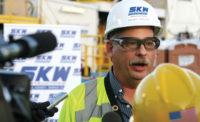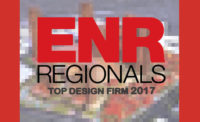Spanning multiple continents and technical disciplines, Stantec regularly places in the upper ranks of ENR’s national list of the Top 500 Design Firms. The Edmonton, Alberta-based firm’s corporate footprint includes New England states, with more than 260 licensed architects and engineers located in 14 offices.
But while being part of a global enterprise offers many advantages, Stantec’s New England leadership strives to project the positive attributes of a far smaller organization. “Because we manage business at a local level, clients see us as very reachable and available,” explains Peter Howe, Stantec regional leader for transportation. “At the same time, many of our projects are large and complex, requiring a certain depth of expertise and depth of talent that Stantec has in most every discipline needed.”
Adds Bob Corning, regional leader for planning, landscape architecture and urban development, “Every office is community-bound, which helps reduce the scale of the company.”
That approach makes a difference to clients such as Todd Fremont-Smith, senior vice president of Boston-area developer Nordblom Co., who is working with Stantec to repurpose the Boston Globe newspaper’s former 695,000-sq-ft headquarters into The BEAT, a mixed-use creativity hub. “You know they can tap a lot of expertise,” Fremont-Smith says, “but on a day-to-day basis, they retain a small-firm aesthetic that is unique for larger firms.”
Stantec’s success in applying the principle of thinking globally while acting locally is one of many reasons the firm was selected as ENR New England Design Firm of the Year. The company reported more than $194 million in regional revenue in 2019, a 60% increase since 2018, and was ranked No. 2 in ENR New England’s Top Design Firms list.
Not limited to a single market sector, Stantec is able to apply its expertise and resources across a broad swath of high-profile public- and private-sector opportunities, ranging from designing foundations for monuments honoring victims of the 2013 Boston Marathon bombing to a major internal roadway upgrade at the city’s Logan International Airport.
Transportation is but one of the region’s many infrastructure needs, according to Stantec senior principal Chris Yannoni, who oversees water projects in the region. “Many water and sewer systems are aging and vulnerable to failure, particularly in the older cities,” he says, adding that while Boston and other cities have benefited from a strong economy in recent years, “infrastructure upgrades are critical to keeping [the region] going and improving quality of life.”
Howe points to the Stantec-designed replacement of 1960s-era roadways and structures between Terminals B and C at Logan Airport as an example. “This project has everything you can imagine—technical complexity, a compact site in the heart of the airport and an accelerated schedule, all while using traditional design-bid-build delivery,” he says. “That brings huge challenges with constructibility and phasing, so a large mix of disciplines are needed make it happen, from structural to geotechnical.”
Thinking Ahead
Experience has also helped Stantec’s architecture and interior design services adapt to the accelerated pace of private-sector projects.
“Clients have become more eager to get shovels in the ground as quickly as possible,” says Stantec architecture principal Colleen Arria. “We’ve developed a large library of projects, giving us a foundation to build on and move quickly in advancing a project.”
Increased use of virtual reality and other tools also helps clients engage and make decisions sooner, creating what Arria calls “a more interactive, collaborative design process that is much more productive and fun for clients.”
“Clients have become more eager to get shovels in the ground as quickly as possible.”
– Colleen Arria, Principal, Stantec
That might seem a rather unusual way to characterize a complex renovation challenge such as The BEAT’s core building, which Nordblom plans to transform from its industrial newspaper production past into a mix of office, laboratory and flex/industrial uses to stimulate growth in fields such as robotics, life sciences and high-tech manufacturing. The BEAT will also include space for retail and amenities such as a fitness center and a craft micro-brewery.
Nordblom’s Fremont-Smith recalls the existing three-story concrete-framed structure his company purchased in late 2017 as being “a post-industrial mess,” rife with vestiges of the past that included warrens of offices and hallways and infrastructure supporting massive printing presses that once churned out hundreds of thousands of newspapers every day. “While we had a vision of what we wanted to do, Stantec was way ahead of us in understanding the physicality of the building—the way the structure would have to be torn apart and put back together again to achieve it,” he says. “Having that incredible unifying architectural vision during the permitting phase was crucial in helping neighborhood groups and planning authorities recognize the project as good architecture and a creative reuse of the building.”
Having all the needed architectural, engineering and environmental disciplines under one roof was an added benefit, Fremont-Smith adds. “Ten years ago, we would have more likely hired a variety of different consultants and tried to manage that process ourselves,” he says. Along with being more efficient, having a single source of design services “allows us to do more deals.”
Post-Pandemic Paradigm Shift
Stantec’s New England professionals now apply their forward-thinking perspective to the many shifts brought on by the COVID-19 outbreak. Arria believes that while the protracted isolation generated by state and local stay-at-home mandates will fuel a desire to reengage with other people, “we’ve also learned a lot about working remotely, which will require a reimagining of the conventional workplace.”
The nature of public spaces in the urban environment also will likely change. Corning cites a mixed-use project in Newton, Mass., for which Stantec recently held a design charette shortly before the outbreak occurred. One of the planning considerations for a central green space was the number of yoga mats the space could accommodate. “Obviously, the dynamics of interaction and programming for the public realm will change,” he says.
The region’s infrastructure will be affected as well, as reduced state and local revenue leaves public agencies with less money to fund needed upgrades. One way to help, Yannoni says, is integrating automation and real-time monitoring technology into water and sewer systems to improve operations while also reducing long-term costs.
Similarly, Stantec’s expertise in infrastructure management could yield other solutions for stretching transportation budgets. “Our assessments of pavement, utilities and structures can help owners prioritize spending and explore options to extend the life of their assets without resorting to wholesale replacement,” Howe says.
While the coming months are shrouded in uncertainty, Corning is confident the Boston design market has the resilience to recover relatively quickly, noting that project funding remains and design has continued. “Probably about 95% of projects will go ahead,” he says. Arria agrees, citing the region’s strong science and biotechnology sector, with many firms involved in researching virus treatment alternatives. If there’s a potential downside, it’s the long-standing shortage of skilled craft workers. “Our market will continue to flourish, but we still need [them] to get those projects done,” Arria says.
Stantec’s commitment to communities it serves isn’t in short supply. In addition to participating in the firm’s worldwide week of community service every September, New England offices have supported more than 80 organizations of all sizes and missions over the last year. One of the most anticipated events for the Boston offices is an annual sponsorship of the Jimmy Fund Scooper Bowl, the nation’s largest all-you-can-eat ice cream festival, where volunteers team up to scoop ice cream. “It’s the same mindset that we bring to our projects,” Corning says, “solving problems and providing benefit for the community.”
Stantec’s High-Profile New England Projects Include:
Dry Dock Modernization
Portsmouth Naval Shipyard
Kittery, Maine
As part of a five-year, $60-million indefinite delivery/indefinite quantity contract to provide multidisciplinary waterfront architect-engineering services for the U.S. Naval Facilities Engineering Command, Stantec is handling approximately $35 million worth of planning and preliminary engineering projects aimed at upgrading dry docks used to repair and modernize U.S. Navy submarines. Stantec has provided design services at the nation’s second-oldest public shipyard for more than 60 years.
Phase III Combined Sewer Overflow (CSO) Control Program
Narragansett Bay Commission
Providence
Stantec is program manager for a $755.6-million capital program designed to improve water quality in the Seekonk River, Providence River and Upper Narragansett Bay in compliance with a Rhode Island Dept. of Environmental Management consent agreement. To be constructed over 20 years, Phase III includes the 13,000-linear-ft deep-rock Pawtucket Tunnel, a smaller connecting stub tunnel, a tunnel dewatering pump station and interceptor relief facilities.
Boston Marathon Bombing Markers
Boston
Stantec worked with sculptor Pablo Eduardo to integrate monuments honoring victims of the 2013 Boston Marathon bombing near the race’s finish line. In addition to navigating a web of underground utilities to locate foundations for the memorial’s four 1,200-lb hollow bronze spires, Stantec engineers used a robust system of piles extending up to 37 ft deep to deal with poor soil conditions.








Post a comment to this article
Report Abusive Comment